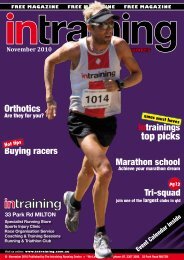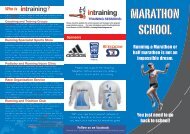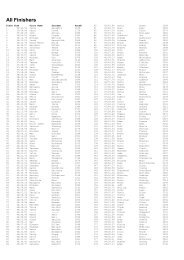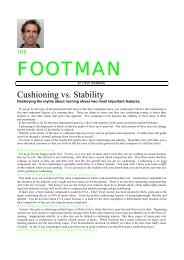Part 4: 'RACING the Marathon' By Steve Manning Now ... - Intraining
Part 4: 'RACING the Marathon' By Steve Manning Now ... - Intraining
Part 4: 'RACING the Marathon' By Steve Manning Now ... - Intraining
You also want an ePaper? Increase the reach of your titles
YUMPU automatically turns print PDFs into web optimized ePapers that Google loves.
<strong>Part</strong> 4: <strong>'RACING</strong> <strong>the</strong> <strong>Marathon'</strong><br />
<strong>By</strong> <strong>Steve</strong> <strong>Manning</strong><br />
<strong>Now</strong> that you have done all of <strong>the</strong> training it is time for <strong>the</strong> race itself. If <strong>the</strong><br />
training has gone well you should have <strong>the</strong> confidence, skills and fitness to<br />
achieve your goals in <strong>the</strong> marathon.<br />
Some runners who are well prepared do not achieve <strong>the</strong>ir goals. This is usually<br />
because <strong>the</strong>y do not have a realistic idea of what <strong>the</strong>y can do, or <strong>the</strong>y use poor<br />
tactics in <strong>the</strong> race itself. The months of great training are a waste if you do not<br />
run properly on <strong>the</strong> day.<br />
You must have a race plan that is both realistic and flexible. It is important that<br />
you have a very good understanding of your plan. That way you can think on<br />
your feet in <strong>the</strong> race itself. Everything will be under control and you can focus on<br />
getting <strong>the</strong> best out of yourself instead of dealing with your mistakes.<br />
Follow <strong>the</strong> advice in this article and it will be a major step in racing <strong>the</strong> marathon<br />
well in Sydney.<br />
PREDICT YOUR GOAL TIME:<br />
After running a personal best in your last 10km race before <strong>the</strong> big marathon you<br />
wonder about how fast you can realistically run on <strong>the</strong> main day. It is unrealistic<br />
expectations that generally are <strong>the</strong> major cause of despair in <strong>the</strong> longer races.<br />
It is impossible to think that you can continue your 10km pace for a Marathon no<br />
matter how much mileage you might have done beforehand. In a race endurance<br />
becomes a secondary issue to anaerobic thresholds and efficiency. Setting a<br />
realistic goal for <strong>the</strong> marathon will help you succeed. An accurate prediction of<br />
<strong>the</strong> probable slowdown between different distances may save you grief. A proven<br />
formula is to take your 10km time and multiply it by 4.666 to get your Marathon<br />
time. This marathon time can <strong>the</strong>n be divided by 2.1 to give you your half<br />
marathon time. The chart below gives you some comparison times for various<br />
common target times.<br />
A word of caution for <strong>the</strong>se predictions is that <strong>the</strong>y may vary considerably and are<br />
dependent on a number of important factors. You must have done <strong>the</strong> necessary<br />
long runs to be able to achieve your marathon times, and <strong>the</strong> speedwork to<br />
achieve your 10km times. The targets are still challenging goals and must be<br />
adapted to cope with varying conditions and type of courses. The o<strong>the</strong>r thing to<br />
remember is that many races are not measured accurately. Predictions and goals<br />
with a margin for error can give you <strong>the</strong> confidence to go for your best time on<br />
race day.<br />
Use <strong>the</strong> following formula to determine if you have set yourself a realistic goal:<br />
10km time x 4.66 = marathon<br />
INTRAINING Running Centre<br />
40 High Street, Toowong, 4066, Brisbane, QLD, Australia<br />
tel: 07 3371 7811 | fax: 07 3870 5687<br />
e: shop@intraining.com.au | web: www.intraining.com.au
half marathon time x 2.1 = marathon<br />
You can predict your half marathon time from a 10km race by converting it to <strong>the</strong><br />
marathon first and <strong>the</strong>n back to half marathon.<br />
10 km Marathon Half Mar.<br />
x 4.666 ÷ 2.1<br />
1:04 5:00 2:23<br />
1:00 4:40 2:13<br />
51 4:00 1:54<br />
50 3:53 1:51<br />
45 3:30 1:40<br />
40 3:07 1:29<br />
38 3:00 1:25<br />
36 2:48 1:20<br />
RACE TACTICS AND STRATEGIES<br />
The most frequent mistake made in a marathon is starting too fast. The<br />
excitement and atmosphere of <strong>the</strong> race makes it feel easy running fast. The<br />
greater number of runners around you is also confusing for your pace judgement.<br />
If you started behind <strong>the</strong> start line and had to weave your way through o<strong>the</strong>r<br />
runners, <strong>the</strong>n <strong>the</strong> first kilometre split may be slow even though you have<br />
expended considerable energy. Be cautious at <strong>the</strong> start, many marathon efforts<br />
are ruined in <strong>the</strong> first five kilometres.<br />
Some people believe that a time cushion should be created to insure against <strong>the</strong><br />
inevitable slowdown in <strong>the</strong> last ten kilometres. Physiologically this is a dangerous<br />
method as too much glycogen is burned initially and <strong>the</strong> runner can never recover<br />
<strong>the</strong> balance of fat metabolism. Throughout every race <strong>the</strong>re is a combination of<br />
anaerobic and aerobic energy being used at all times. The faster you go <strong>the</strong> more<br />
of your glycogen stores are used. In short races it is not so important, but over<br />
marathon distances it is possible to completely deplete your glycogen reserves.<br />
When this occurs you will slow down considerably. For this reason it is preferable<br />
to burn as high a percentage of fat as early as possible. The slower you start <strong>the</strong><br />
greater <strong>the</strong> concentration of fat metabolism.<br />
INTRAINING Running Centre<br />
40 High Street, Toowong, 4066, Brisbane, QLD, Australia<br />
tel: 07 3371 7811 | fax: 07 3870 5687<br />
e: shop@intraining.com.au | web: www.intraining.com.au
So <strong>the</strong> best way to pace yourself is to start slower than goal pace, run 5 to 30 km<br />
slightly faster, and finish at pace. This means that you are behind time until 30km<br />
but by <strong>the</strong>n you are travelling faster than goal pace and can still slow down and<br />
achieve your goal. It is also a lot of motivation to be passing people later in <strong>the</strong><br />
race and physically much easier to handle. Consult <strong>the</strong> race plans below to create<br />
your own ideal pacing strategy.<br />
The most important part of pacing is to make sure you have a realistic idea of<br />
how fast you can run. You should adjust your goals and your pacing based on <strong>the</strong><br />
conditions and how you feel on <strong>the</strong> day. Keep a record of your splits during <strong>the</strong><br />
race so that you can identify if you have done something wrong and learn how to<br />
run better next time.<br />
THE RACE PLAN<br />
5hour Marathon = 7:06/km<br />
0 to 5km @7:30 = 37:30<br />
5 to 30km @7:00 = 2:55:00<br />
30 to 42.2 @7:10 = 1:27:30<br />
4hour Marathon = 5:41km<br />
0 to 5km @5:50 = 29:10<br />
5 to 30km @5:35 = 2:19:35<br />
30 to 42.2 @5:45 = 1:10:10<br />
3:30 Marathon = 4:58/km<br />
0 to 5km @5:10 = 25:50<br />
5 to 30km @4:55 = 2:02:55<br />
30 to 42.2 @5:00 = 61:00<br />
3hour Marathon = 4:16/km<br />
0 to 5km @4:30 = 22:30<br />
5 to 30km @4:12 = 1:45:00<br />
30 to 42.2 @4:18 = 52:27<br />
INTRAINING Running Centre<br />
40 High Street, Toowong, 4066, Brisbane, QLD, Australia<br />
tel: 07 3371 7811 | fax: 07 3870 5687<br />
e: shop@intraining.com.au | web: www.intraining.com.au
SYDNEY COURSE FEATURES<br />
The celebrating sport Sydney marathon has a few special features that should be<br />
considered when creating your race plan. The first one is that over 5000 runners<br />
will be at <strong>the</strong> start and this will make it a little bit more difficult to run freely in<br />
<strong>the</strong> beginning. There is a wide start area so it should not take too long to pass<br />
<strong>the</strong> start line but it may take up to a kilometre to run freely. If you struggle to<br />
wind your way through <strong>the</strong> crowd to keep on pace <strong>the</strong>n it will be a much greater<br />
effort than it should be. It is a downhill start so this alone may make you run too<br />
fast anyway and requires special caution. The best thing to do is start in <strong>the</strong> pack<br />
where you should be, be patient, and do not worry about your splits until you are<br />
able to run freely.<br />
The Sydney course has a net elevation drop in <strong>the</strong> first half with some difficult<br />
hills at <strong>the</strong> end. This means negative splits will be difficult. If you run too fast in<br />
<strong>the</strong> first half to be ahead of pace you may totally blow up when you hit <strong>the</strong> hills.<br />
Make sure you have plenty in <strong>the</strong> tank for <strong>the</strong> final 10km.<br />
The course is on major roads with little protection. Luckily <strong>the</strong> sun will be at our<br />
backs in <strong>the</strong> final third of <strong>the</strong> race. This increased exposure might require extra<br />
protection like a lightweight cap and sunglasses. Dehydration is also likely to be a<br />
major factor so drink frequently.<br />
Running marathons is about efficiency more than power or speed. Try to run at<br />
an even effort level regardless of <strong>the</strong> terrain. Do not surge <strong>the</strong> downhills too hard.<br />
Run <strong>the</strong> uphills with <strong>the</strong> goal of protecting your reserves as much as possible.<br />
Aggression has little place in <strong>the</strong> marathon. Intelligence is what is needed. Do not<br />
attack <strong>the</strong> hills at <strong>the</strong> end just because you are feeling good. It is possible to go<br />
from feeling great to walking within just a kilometre. No matter how good you<br />
feel it is nearly impossible to run faster in <strong>the</strong> last 10km of <strong>the</strong> race unless you<br />
have been running well within yourself or you are a world class athlete.<br />
CONTINGENCY PLANS<br />
It is important to focus on <strong>the</strong> positives during <strong>the</strong> race. Negative thoughts will<br />
just slow you down. The time to think about what can go wrong is before <strong>the</strong> race.<br />
You should consider what to do, and visualise your response, to a variety of<br />
problems you might encounter in <strong>the</strong> race.<br />
With a large field it is more likely that you might be tripped and fall over. You<br />
should think about protecting yourself as much as possible as you fall and getting<br />
to your feet as quickly as possible after you land. If you have thought about your<br />
response beforehand <strong>the</strong>n it will become automatic and you will not have to think<br />
about what to do when it happens. This means a quicker response as well as a<br />
better response.<br />
Missed drinks, toilet stops, bad pacing and vocal running partners can all<br />
contribute to negative thoughts and use up precious adrenaline. Think about what<br />
to do in each situation in order to cause <strong>the</strong> least worry and emotional tension.<br />
Sometimes just knowing that <strong>the</strong>re is nothing that can be done and getting on<br />
with <strong>the</strong> job is <strong>the</strong> best thing for you in <strong>the</strong> long run.<br />
INTRAINING Running Centre<br />
40 High Street, Toowong, 4066, Brisbane, QLD, Australia<br />
tel: 07 3371 7811 | fax: 07 3870 5687<br />
e: shop@intraining.com.au | web: www.intraining.com.au
Blisters, cramps and stitches can all cause pain and force you to slow down. Have<br />
strategies to deal with <strong>the</strong>se issues so that you lose <strong>the</strong> least amount of time as<br />
possible.<br />
Injury and illness are not something to be ignored. Sometimes <strong>the</strong> best decision<br />
is to pull out. I know of many cases of people running a marathon with a slight<br />
injury and not being able to run again for months if ever. Illness can be even<br />
more dangerous. Some viruses cause an inflammation of <strong>the</strong> heart muscle.<br />
Strenuous exercise particularly in hot conditions can cause permanent damage to<br />
<strong>the</strong> heart. There are quite a few cases of young normally healthy people who<br />
have died because of a slight virus that affected <strong>the</strong>ir heart. While this marathon<br />
may have been a goal for over a year it is not worth <strong>the</strong> end of your running or<br />
your life.<br />
MENTAL STRENGTH AND FOCUS<br />
Marathons are a challenge. You will be pushing your body beyond what it is<br />
designed to do. Hopefully your training will mean that you are well prepared to<br />
explore your physical limits. But no matter how well you have trained, <strong>the</strong>re will<br />
come a time in <strong>the</strong> race when you start to struggle. It is at this time that <strong>the</strong><br />
strong are separated from <strong>the</strong> weak. The strength that is required is mental<br />
strength. It is a factor of determination, concentration, courage, focus, pain<br />
tolerance, control and intelligence.<br />
Some of <strong>the</strong>se factors are innate and can not be trained. Speedwork and o<strong>the</strong>r<br />
races can help you learn that you can push yourself and that <strong>the</strong> pain is<br />
temporary and you will survive. But nothing like a marathon can give you <strong>the</strong><br />
experience required to keep pushing when your whole body aches, every step is<br />
an effort, your brain is telling you to walk and it feels like you are starving to<br />
death.<br />
The main thing is to keep positive and focus on things that will keep you going<br />
ra<strong>the</strong>r than <strong>the</strong> things that will slow you down. At 35km when it starts to get<br />
tough think "it is only 7km to go, not even <strong>the</strong> distance of my easy runs, I have<br />
run this heaps of times before'. That is much better than thinking 'how am I ever<br />
going to make 42km?' Draw strength from all <strong>the</strong> training you have done.<br />
RACE NUTRITION AND HYDRATION<br />
Hopefully you have started <strong>the</strong> race well hydrated and carbo loaded. Marathons<br />
are too far to get through without some added help. Dehydration is <strong>the</strong> most<br />
likely cause of slowing down. You should start to drink early as possible and as<br />
frequently as possible. This does not mean stopping to have two cups of water at<br />
every aid station. Your body can only absorb 150mls every 15 minutes in <strong>the</strong> best<br />
of conditions. The reality is that you can probably only get down two gulps of<br />
water at each aid station. More than this and you will get bloated, your stomach<br />
may shut down and you will get dehydrated. The goal is to drink smaller amounts<br />
more frequently.<br />
INTRAINING Running Centre<br />
40 High Street, Toowong, 4066, Brisbane, QLD, Australia<br />
tel: 07 3371 7811 | fax: 07 3870 5687<br />
e: shop@intraining.com.au | web: www.intraining.com.au
Your body has enough energy stores to run more than ten marathons without<br />
eating. Most of this energy is fat. When running glycogen is <strong>the</strong> fuel of choice.<br />
Many runners will have inadequate stores of glycogen in <strong>the</strong> muscles and liver.<br />
Supplementing <strong>the</strong>se reserves with a sports drink or carbohydrate gels may make<br />
you feel better for longer by making <strong>the</strong>se reserves last. Do not (I repeat DO<br />
NOT!) try anything new in <strong>the</strong> marathon. Try <strong>the</strong>se supplementations in long runs<br />
first to make sure you can cope with <strong>the</strong> taste and <strong>the</strong> strength. O<strong>the</strong>rwise you<br />
may be vomiting on <strong>the</strong> side of <strong>the</strong> road instead of running on strongly.<br />
RACING SHOES?<br />
Racing shoes help you run faster by reducing <strong>the</strong> weight you have to carry over<br />
42.2kms. They also have less cushioning so <strong>the</strong>y allow you to transfer more of<br />
<strong>the</strong> power from your stride to <strong>the</strong> ground. The down side is <strong>the</strong>y have less<br />
protection and stability.<br />
Only a few runners are able to run in a marathon with racing shoes. They are<br />
usually faster and have better biomechanics. A good rule of thumb is that you<br />
should be running faster than 4:30/km (3:10 marathon) to get a benefit that is<br />
better than <strong>the</strong> risk. And this is only if your running form is good. Most people will<br />
lose more time from <strong>the</strong> loss in efficiency from pounding and lack of stability. It is<br />
also good to remember that racing shoes let you run faster but cause more<br />
damage. If you are carrying an injury do not wear racers. There are many<br />
lightweight training shoes that are more appropriate for most people to wear in<br />
<strong>the</strong> marathon.<br />
Marathons are wonderful experiences. It is because of <strong>the</strong> difficulty of running<br />
<strong>the</strong>m successfully, that you get so much satisfaction when you complete <strong>the</strong>m.<br />
Make sure that you enjoy <strong>the</strong> experience. Do not worry so much about what you<br />
must do in <strong>the</strong> race that you miss <strong>the</strong> excitement and joy out of running in it.<br />
Cross that line with a big smile for <strong>the</strong> camera. Too many people finish with <strong>the</strong>ir<br />
head down looking at <strong>the</strong>ir watch. No matter how you run or whe<strong>the</strong>r you have<br />
achieved your time goals, remember that just finishing is a great achievement in<br />
itself.<br />
<strong>Steve</strong> will be pacing a group to finish under 3:30 at Sydney so you are welcome<br />
to introduce yourself at <strong>the</strong> start and join his group.<br />
INTRAINING Running Centre<br />
40 High Street, Toowong, 4066, Brisbane, QLD, Australia<br />
tel: 07 3371 7811 | fax: 07 3870 5687<br />
e: shop@intraining.com.au | web: www.intraining.com.au









